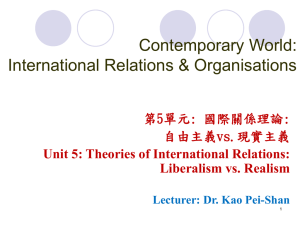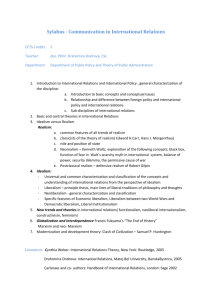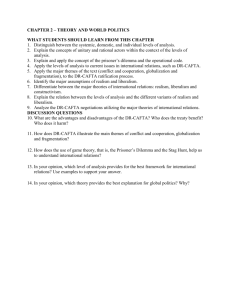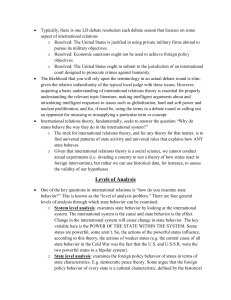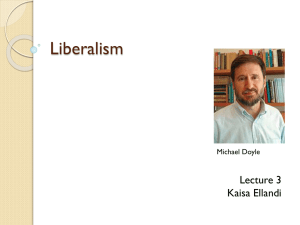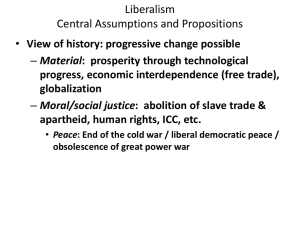Does liberalism provide a viable alternative to realism as
advertisement
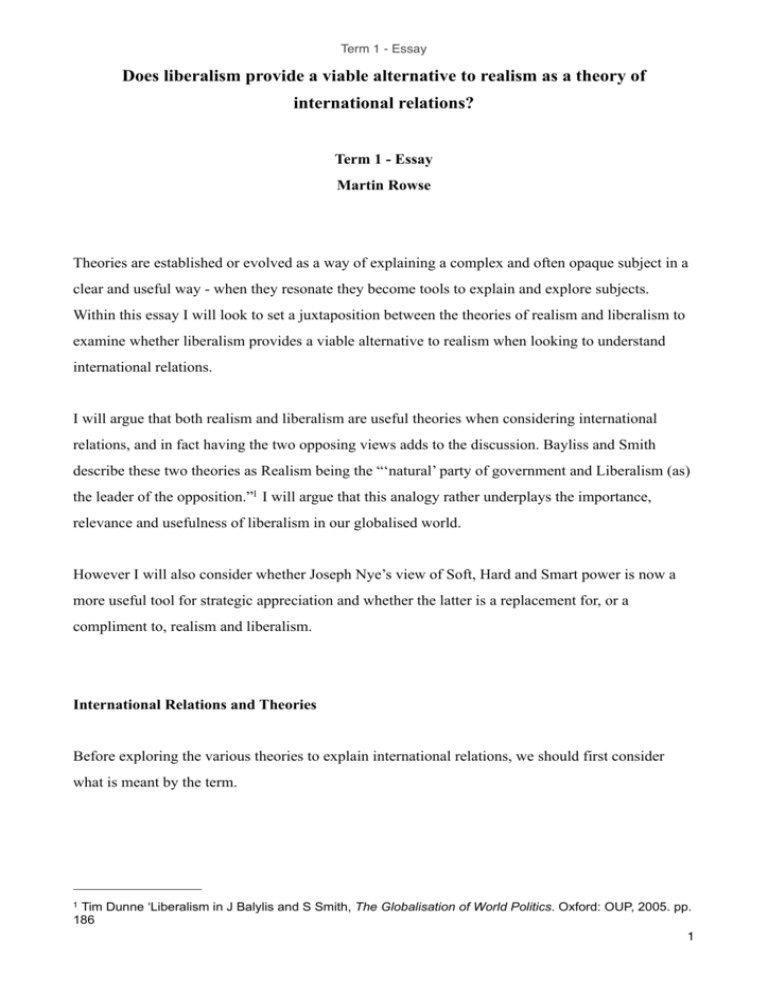
Term 1 - Essay Does liberalism provide a viable alternative to realism as a theory of international relations? Term 1 - Essay Martin Rowse Theories are established or evolved as a way of explaining a complex and often opaque subject in a clear and useful way - when they resonate they become tools to explain and explore subjects. Within this essay I will look to set a juxtaposition between the theories of realism and liberalism to examine whether liberalism provides a viable alternative to realism when looking to understand international relations. I will argue that both realism and liberalism are useful theories when considering international relations, and in fact having the two opposing views adds to the discussion. Bayliss and Smith describe these two theories as Realism being the “‘natural’ party of government and Liberalism (as) the leader of the opposition.”1 I will argue that this analogy rather underplays the importance, relevance and usefulness of liberalism in our globalised world. However I will also consider whether Joseph Nye’s view of Soft, Hard and Smart power is now a more useful tool for strategic appreciation and whether the latter is a replacement for, or a compliment to, realism and liberalism. International Relations and Theories Before exploring the various theories to explain international relations, we should first consider what is meant by the term. Tim Dunne ‘Liberalism in J Balylis and S Smith, The Globalisation of World Politics. Oxford: OUP, 2005. pp. 186 1 1 Term 1 - Essay International relations can be used to describe the academic pursuit to gain an understanding of how nations interact with each other 1. However, I would argue that in the globalised and multistakeholder world that now exists, that a focus purely on the states involved will not be able to fully explain the actions and reactions on the international stage. For this essay I would describe international relations as the interactions of all stakeholders involved in setting nationally interested policies and the related diplomacy required to execute said policies 2. This wide view of international relations will test both realism and liberalism since both theories were established to explain the actions and reactions of the individual citizen, but have subsequently been grafted on to the study of state systems 3. Therefore, both theories look to extrapolate the individual to the system view. This also suggests that both theories look to the state as the principle actors. Of course, we should also constitute what it means in terms of the usefulness of a theory. For this I would like to use the primary objective of being able to predict the turn of events in international relations before occurrence. This would show that the theory is useful in order to evaluate the current circumstances and therefore extrapolate to the future direction of a state and the actors. The secondary objective I would like to use is to provide a clear narrative or express a logic following a set of events or direction, this is using the tool to explain the past decisions of a state and the actors. I have set these objectives as theory is often accused of being able to explain history very well (meeting secondary objective) but inadequate when looking to predict the future (primary objective). Realism: the natural home for international relations It is easy to argue that realism has been the predominant theory in the previous decades, this is most prevalent in the language and naming principles of the epochs throughout time which are always 1 Waltz: Theory of international politics, http://wikisum.com/w/Waltz:_Theory_of_international_politics, accessed 17/11/11 2 Robert Cooper, The Breaking of Nations, Order and Chaos in the Twenty-First Century, Atlantic, London, 2004. pp.23 3 Hazel Smith, Democracy and International Relations. Macmillan Press, 2000. pp11 2 Term 1 - Essay pre- or post- a named conflict. This is at first glance not significant, but if you consider the naming principles in other areas of academia they represent a type of thought or in art the style of painting. This is an important distinction, as the naming principle often sets the language that will be used to describe events, and when each era is described in the context of a conflict then it is natural to consider that conflict as the key differentiator. It is also true to say that realism has a natural home in international relations, which has always traditionally focused on the conflicts and tensions between nations, with realism “depicting a world characterised by security competition and war”1. This could be in part due to the large-scale conflicts that have shaped and re-shaped the world in the last century, with realism providing a useful theory to assist in understanding the conflict-led means of ordering the world. The most recent of which was the Cold War which proved realism on the global scale as the bi-polar world between the US and USSR seemingly edged closer to conflict through continuous competition suggesting a anarchic world competing for survival and dominance. There are three main types of realism which have been developed as the theory is continually challenged by actual events. Classical Realism focuses on the innate desire for humans to dominate one-another and extrapolates this view to states. Neorealism suggests that all states are seeking to survive within an international system, but as that system is anarchic in nature each state must survive on its own. Burchill describes this as states being “thwarted by the absence of an overarching authority which regulates their behaviour towards each other.”1 The latest addition to Realism is the Offence-Defence Theory, which suggests that “war was more likely when states could conquer each other easily. When defence was easier than offence, however, security was more plentiful, incentives to expand declined and cooperation could blossom.”2 This line of thought may seen fairly logical, that a state will only engage another state where it believes it has the ability to win. However, it could be used to explain why the number of state-on-state actions has decreased3 without discounting the whole realist way of thinking. It also rather simplistically places nations alongside each other as “‘like-units’ engaging in instrumentally rational decision 1 J J Mearsheimer, The Tragedy of Great Power Politics. Norton, New York, 2001. pp.30 2 S Walt, ‘International Relations: One World, Many Theories’, Foreign Policy No.110, pp. 31 H Buhaug, S Gates et al. Global trends in armed conflict, International Peace Research Institute, Oslo. http://www.regjeringen.no. Accessed 04/10/11. 3 3 Term 1 - Essay making.”1 It is both the simplicity of understanding nations as ‘like-units’ as well as the notion of states acting perfectly rationally which if often cited as a reason against realism. Realism is certainly an easier theory to define, and provides a simple measure for the casual observer of international relations. Realism is also measurable in terms of the successful conflicts and the military machinery which is a physical show of strength even during times of peace. However, realism tends to focus on a state’s dominance and military might as the soul objective of a state, with realists like Mearsheimer admitting that states often look to pursue non-security goals as well2 . With all forms of realism we must also face the implicit implication that “...such a strong statecentric ontology gives rise to deterministic tautology (states seek power because they seek power)...”3 This argument therefore renders the realist viewpoint circular in nature, and therefore less useful in terms of understanding the reasons behind behaviours. This focus on power and conflict may also mean that we fail to notice other changes in the international relations environment, especially in terms of how different nations solve problems and disagreements, with the focus shifting towards cooperation. Nye describes realism as assuming “that in the anarchic conditions of world politics, where there is no higher international government authority above states, they must rely on their own devices to preserve their independence, and that when push comes to shove, the ultima ratio is the use of force.”4 With this in mind it could be argued that each new state-on-state conflict strengthens the case for realism and in turn weakens the case for liberalism, it shows - as Nye suggests - that conflict will occur where there is no higher international authority. At first sight this is a compelling argument, especially considering that liberalism has no similar way to demonstrate it’s ‘success’ as a theory as the number of conflicts avoided through diplomacy and international organisations is not recorded or clear. I would therefore suggest that this argument is disingenuous, since one theory has a clear demonstration of when it is correct (i.e. occurrence of 1 Smith, Democracy and International Relations, pp14 2 Mearsheimer, The Tragedy of Great Power Politics, pp.46 3 Smith, Democracy and International Relations, pp9 4 Joseph Nye, The Future of Power. Public Affairs, 2011. pp19. 4 Term 1 - Essay conflict) where liberalism has no such clear measure. This is also discussed later where Liberalism is often popular following a conflict to develop a solution. Although Nye recognises the importance of realism and the use of force he suggests that as a theory it “represents a first cut at portraying some aspects of international relations… security is not the only major outcome that [nations] seek, and force is not always the best instrument available to achieve those outcomes.”1 Liberalism: when international relations is more than conflict One could explain liberalism as having a focus on peaceful-coexistence, where it looks to explain how nations can exist side-by-side within a stable and ordered international system - it looks to ‘self-restraint, moderation, compromise and peace’2. This is not necessarily the opposite of realist thinking where the world is in constant tension and conflict, but liberalists see institutions and mechanisms other than conflict as a solution. Liberalism espouses an international system constituted of institutions which combine multiple states, where realism only sees anarchy in and conflict inevitable between states. The Liberalist way of thinking is made of four main pillars 3: Citizenship All Citizens are equal and possess certain basic rights to eduction, free press and religious tolerance Legitimacy The legislative authority only possesses the authority invested in it by the people Property The right to own property is key to individual liberty Trade The most effective system of exchange is through the markets 1 Nye, The Future of Power, pp19 2 Hoffmann extract within J Balylis and S Smith, The Globalisation of World Politics. Oxford: OUP, 2005. 3 Walt, ‘International Relations: One World, Many Theories’, pp. 32 5 Term 1 - Essay Liberalists see a direct extension between domestic and international, with each of the Pillars above being extrapolated from state to international institution. It is seen as an “inside-out” theory from this respect as it looks at how best to translate domestic policy in to the international relationships 1. This is an important distinction when considering whether Liberalism is a viable theory to understand international relations, especially since it also considers how best to ensure the legitimacy of policy through international organisations and mechanisms. As with Realism there are a number of schools of thought; but each one reflects the main principle that “the crucial variables in explaining the behaviour of states at the international level relate to the domestic level.”2 Essentially, the behaviour of the domestic is amplified to the international level, but not significantly changed. The first school argues that Economic Interdependence - the inter-twining of states’ economies will discourage conflict as this would result in damage to both. This element of theory has two different explanations for why this is so; the first suggests that economic prosperity leads to a satisfaction of the state and therefore less enthusiasm or motivation for risking the level of prosperity. This is especially true in democracies, where the will of the people will be to maintain prosperity and focus on stability. The other theory is more simplistic in logical terms; explaining that starting a conflict in an economically interdependent system would be the equivalent of “biting the hand that feeds you”3 since you would be destroying (in some way) a combination of the supply and the demand of the economies involved. Secondly, a view that the spread of democracy itself would lead to peaceful coexistence, the socalled Democratic Peace Theory. This does not mean that democracies are any more peaceful per se, but “democracies rarely go to war against each other.”4 This theory largely rests on the existence of either ‘good’ democratic states, or ‘bad’ (sometimes referred to as ‘evil’) states which are 1 S Burchill, ‘Liberalism’ in S Burchill et al, Theories of International Relations. Palgrave 2005. pp81. D Pante and T Risne, ‘Liberalism’, in T Dunne and S Smith, International Relations Theory. OUP, 2007. pp91. 2 3 Mearsheimer, The Tragedy of Great Power Politics, pp.16. 4 D Pante and T Risne, ‘Liberalism’, pp 96 6 Term 1 - Essay undemocratic, such as a dictatorship. It is seen that the ‘good’ states rarely start conflicts with each other, but do enter in to conflict with the ‘bad’ states. This has recently been seen in the invasion of Iraq in 2003 where the US-led alliance sought to depose the dictator, Saddam Hussein and instigate a democracy. This is of course only one of the reasons for the invasion, but represents a recent example. These theories reverse the traditional realist theory that all countries are threatened and in constant competition with each other. Instead it suggests that “[t]he success of some was not threatening to others. It was their failure that was threatening.”1 In an increasingly dependent world, each country relies on the success and stability of others. Finally, the theory of International Institutions which focuses on the pacifying nature of the institutions that have been set up in the preceding decades.2 The realist view described above suggests that the international realm is one of anarchy where each state acts alone with no higherlevel institution ruling over the states. The liberalist view does not entirely oppose this view in that there is no ‘over lord’ of the international system, rather a set of institutions that are negotiated, agreed and entered in to by the nation states 3. Once the states have agreed to joining an international institution (for example the UN, NATO or the EU4) an agreement and coalition or alliance is required to wage war. This makes the decision more difficult as you are relying on multiple actors wishing to embark on the same course of action and this multiplying effect make conflict less likely. An example of this relates to the invasion of Iraq cited above, where a United Nations Security Council Resolution (Resolution 1441) was required to commence the conflict 5. More recently a Resolution to condemn President Assadinstructed crack-down on anti-government protestors in Syria was blocked (via veto) by China and Russia6. 1 Gideon Rachman, Zero-Sum World, Politics, Power and Prosperity after the Crash. Atlantic, London, 2010. pp126 2 D Pante and T Risne, ‘Liberalism’, pp 96 3 Mearsheimer, The Tragedy of Great Power Politics, pp.17 4 United Nations, North Atlantic Treaty Organization, European Union 5 United Nations Security Council Resolutions, http://www.un.org/Docs/scres/2002/sc2002.htm, accessed 11/11/11. 6 China and Russia veto UN resolution condemning Syria, BBC News website, accessed 21/11/11 7 Term 1 - Essay However, as mentioned above, you cannot deny the existence of state-on-state conflict in the 20th Century, which it could be argued removes the importance of Liberalism completely. Liberalism has indeed had intermittent popularity throughout the last century, stemming largely from the conflicts which have marked out the 20th Century, such as the two World Wars and then the Cold War. Rather than take away from the Liberalist theory, I would argue that these conflicts have in fact added substantially to the argument. Most notably the reliance on Liberalist thinking at the end of major conflicts - this includes the League of Nations foundation following the First World War and the establishment of United Nations at the end of the Second World War1. Following the Cold War in the 1990s state leaders began to proclaim a “New World Order” of international institutions and liberal ideas 2. That argument can be counted by suggesting that “The configuration of the system… is the unintended consequence of great power-security competition” since it was organised to maintain the status-quo of the victors’ interests. However, the number of non-security subjects - including Human Rights and ethical considerations2 - that are now being discussed amongst nations may suggest an underlining will be all nations to exist in a system of order, rather than anarchy. If this trend becomes permanent it will once again show the strength of coexistence over the Realist view of conflict as a natural course of events. I would also argue that it is this myriad of international organisations - from state competence, law and standards - that have allowed the level of globalisation that we can now witness. Without the liberalist view that the anarchy can be solved through institutions, globalisation would not have been possible. I would also suggest that this is especially true in business, where international law and standards (such as electrical current and various industrial measurements) have enabled companies to trade with multiple nations, relying on stability and known rules and norms to build increasingly efficient global supply chains. The juxtaposition of Realism and Liberalism 1 P Calvocoressi, World Politics 1945 - 2000. Longman, 2001. pp.151 2 D Pante and T Risne, ‘Liberalism’, pp 186 8 Term 1 - Essay Setting the two theories against each other shows two polar-opposite ways of thinking about international relations. This opposition forces a choice, and therefore fosters discussion. Realism Liberalism State-on-state actions Domestic internal to state International scene of anarchy International Organisations Reflective and history-focused Forward-looking State-focused Citizen-focused Competition Trade Conflict Peaceful co-existence One could argue that liberalism represents a more progressive and optimistic future, as mentioned above it could be said that globalisation has been pursuing liberalist goals throughout the last centuries, when you consider the early companies formed for global trade. Fukuyama’s view was that human progress could be measured in the reduction and eventual elimination of global conflicts through the evolution of legitimate principles in domestic policy.1 Without liberalist thinking, we would not have the United Nations, International Monetary Fund or any of the gradually increasing number of international organisations and the first attempt at creating an international authority in the League of Nations. All these efforts are attempting to prove true Kant’s statement that peace can be perpetual.2 Realists often criticise liberalists for holding these statements as a “utopian view of politics which, if followed, would lead states to disaster”3. This statement suggests that if liberalist views were 1 Scott Burchill, ‘Liberalism’ pp.56 2 Scott Burchill, ‘Liberalism’ pp.58 3 Mearsheimer, The Tragedy of Great Power Politics, pp.15 9 Term 1 - Essay unequivocally followed and defences were lowered then the likelihood of conflict would in fact increase as states would seek the opportunity outlined in the Offence-Defence theory. This popularity could also be driven by financial considerations; with many “states, particularly large ones, find[ing] it more costly to use military force to achieve their goals than was true in earlier times”1 and are therefore looking to reduce the likelihood of conflict through diplomacy and treaties - both which could be termed as forms of liberalism. It could be suggested that realism is now simply too expensive for many states to partake, unless of course as a last resort. This view of an ever increasing number of international institutions and mechanisms that we also see a fall in the number of state-on-state conflicts which would suggest either conflict has been temporarily suspended or perhaps new non-aggressive methods of conflict - such as trade negotiations - have replaced the previous weapons. If you believe in the well known Clausewitzian phrase that ‘conflict is the expression of politics by other means’2 then you can arrive at the view that for liberalism to be successful you require the force prescribed under realism close behind. In simplistic terms, If you are to maintain the stability of international institutions you must have the credible ability and capability to enable destructive force to be unleashed if necessary. This is a particularly interesting point when you consider the link to globalisation and the economic reliance of states on each other; a liberalist view. If - as mentioned above - the real threat to states is the failure of other states (rather than competition through success) then it could be one explanation for the growth of ‘liberal interventionism’ where states look to intervene to aide stability, maintaining the economic interdependence3. It could be argued that this use of realism to protect liberalism represents a new type of hybrid theory. With this in mind, I would suggest that Realism and Liberalism should be placed on a paradigm (Figure 1, below) which provides a useful frame for the theories to be considered within and also represents the balance that is necessary between the two theories to maintain the stability sought. If 1 Nye, The Future of Power, pp.24 2 Clausewitz and His Works, www.clausewitz.com, accessed 16/11/11 3 Rachman, Zero-Sum World, pp129 10 Term 1 - Essay the paradigm becomes unbalanced then states will either wage wars as a way to solve problems or states will look to take advantage of others who seek a purely liberalist path and reduce their defences accordingly. Figure 1: Realism and Liberalism along a Paradigm of Thought An important element that is not fully considered within either realism and liberalism is the use and importance of power. Both theories allude to power, but neither adequately explore the subject and therefore one could argue that neither are able to explain international relations. I will now explore this further and look at how Joseph Nye’s theory of Soft, Hard and Smart Power could be a useful way of expanding both liberalism and realism. Soft, Hard and Smart Power Joseph Nye began to develop an alternative theory to explain power in 1990, with the introduction of ‘soft power’ expanded in his book on the subject in 20041. The work was widely accepted, with the terms entering political and diplomatic circles as a clearer way of expressing national approaches to international relationships. 1 Harvard Kennedy School Faculty, http://www.hks.harvard.edu/about/faculty-staff-directory/joseph-nye, accessed 16/11/11 11 Term 1 - Essay I believe this theory became popular as it enabled the expression of the ‘softer’ side of diplomacy while not removing the military power that may be necessary. This allowed diplomats, those involved in international institutions and military leaders to explain and understand their role in maintaining stability - or using force - with a new clarity and language. Nye himself describes soft power as “the ability to affect others through the co-optive means of framing agenda persuading, and eliciting positive attraction in order to obtain preferred outcomes.”1 Some have argued that this ‘softening’ of power and move away from hard power to the importance of soft and smart is in fact Nye searching for a mechanism to maintain the status-quo of the US as the hegemonic power on earth. The criticism goes that as other states begin to challenge the US’ military might they will remain insufficient in terms of their ability to persuade and use soft power2. Nye includes more realist viewpoints within his latest book, which I would suggest assumes realism as a ‘tool’ in a liberalist institutional arena. Nye suggests that at some points this liberalism breaks down and we return to a position where “States are caught in a zero-sum game where it is rational to fend for themselves because they cannot trust others.”3 I would suggest that Joseph Nye’s view of Power adds to the debate between liberalism and realism rather than replacing either, and in fact could substantiate the intertwined nature of the two grand theories. As mentioned above, I would argue that liberalism and realism should be considered together as a unbreakable paradigm of thinking, with each reliant on the other in the modern world. It is no longer a pendulum of choice but rather an intertwined response, with Nye’s theory able to give a clearer view with detailed criteria of which type of power is in play by linking it directly to leadership 4. Taking this further - and although it is not a perfect match - I would propose that you could draw parallels between liberalism and soft power, realism and hard power, with smart power ultimately being the only type of power which is available for use due to the international institutions which 1 Nye, The Future of Power, pp.20 2 Paul Cammack, Smart Power and US Leadership: A critique of Joseph Nye. http://www. 49thparallel.bham.ac.uk/back/issue22/1_Cammack.pdf. Accessed 21/11/11. 3 4 Nye, The Future of Power, pp.27 Joseph Nye, Soft Power, Hard Power and Leadership, pp3. http://www.hks.harvard.edu/netgov/files/talks/ docs/11_06_06_seminar_Nye_HP_SP_Leadership.pdf, accessed 16/11/11 12 Term 1 - Essay have now almost universally been accepted. As Smith points out “States are strong institutions but they are enmeshed in important regional and universal political and economic institutions. This is the essence of globalisation.”1 Figure 2. Parallels can be drawn between liberalism, realism and power Smart Power was developed by Nye to further explore the mix between Hard and Soft power, suggesting that the exclusive use of either will not lead to the required result, in terms of both the legitimacy of Soft and the end-result of using Hard Power. In a 2008 interview 2 Nye clearly explained how Smart Power could be used in the fight against Terrorism. Nye suggests that soft power could be used to persuade (through aide or threats) the Taliban to reveal the sites used by Al Qaeda, followed by hard power (traditionally kinetic) to destroy the sites. However, this would not solve terrorism but reduce one element, therefore Nye suggests that the smart mixture of hard and soft could be used to win ‘hearts and minds‘ of the mainstream Muslim population to reduce the hardliners ‘available‘ for radicalisation. This raises two interesting elements around Nye’s theories. Firstly; that Nye is himself developing the theories to meet current challenges. Secondly, the theory relies on the existing theories of realism and liberalism as a basis. Nye mentions the use of soft power to persuade the Taliban, a political body which lies outside of the international system, and therefore realists would suggest as part of the anarchic realm. However, discussing the winning of ‘hearts and minds’ of the 1 Smith, Democracy and International Relations, pp24 2 Joseph Nye on Smart Power, http://www.hks.harvard.edu/news-events/publications/insight/international/ joseph-nye, accessed 21/11/11. 13 Term 1 - Essay mainstream Muslim population would suggest there is some form of transmission that could be used; an international institution would be an example of such an instrument. Conclusion Many argue that the theories that we have at our disposal to understand international relations are simply not up to the challenge. Smith rather critically proclaims that “If we want answers to the question why is it that major powers and the major international governmental and nongovernmental institutions are insisting on the promotion of democracy in both the rhetoric of their pronouncements and, sometimes, the foreign policies they pursue, we are left struggling to respond given the theoretical choices available.”1 I would agree to an extent with this rather coarse dispelling of the theories available; however I would argue that when you combine the theories of Liberalism, Realism and Nye’s Power you can begin to build a level of analysis which is useful when looking at international relations. It is true to say that there will often be surprises in store where no theory is able to fully predict events - for example the collapse of the Soviet Union2 and surprise of the Arab Spring3 - but the combination of theories remains useful and can be used as a framework to understand the positions and approach of nations or moreover their leaders. Measuring against the objectives set above; Liberalism clearly enables events in international relations to be understood once they have happened. This is especially true when it involves states which are members of international institutions and where resolutions or agreements are necessary for action. Or where a state leader - President or Prime Minister - has the ambition of joining an international institutions - for trade or political reasons - or has shown evidence of ‘respect’ for those institutions in the past. I would also argue that this type of evidence - stated ambitions or past experience - gives an indication of the behaviour in future events. 1 Smith, Democracy and International Relations, pp1 James F. Collins, Fall of the Soviet Union—The Inside Story, http://carnegieendowment.org/2011/08/18/fallof-soviet-union-inside-story/5tyr. Accessed 21/11/11 2 3 The Arab Spring: A Conversation with Alain Juppé, www.cfr.org, accessed 16/11/11 14 Term 1 - Essay With this in mind, I believe that Liberalism can indeed be a viable alternative to Realism when dealing with International Relations. However, Liberalism only gives an indication or direction of what may happen. I would argue that it does not assist in predicting future events or fully understanding them, as it is simply too blunt a theory. The addition of the Power theory gives further clarity in terms of the tools that would be available and also offers a wider perspective, allowing for the use of hard power in a suitable mix. This therefore enables a liberal to allow for the potential of realism in the form of traditional kinetic force while maintaining the view that international relations is a number of inter-twined international institutions. I would suggest that rather than liberalism being a viable alternative to realism, that neither offer a useful view of international relations as separate theories. The two are in fact better understood when placed together at opposing ends of a paradigm, with Power theory adding substantially to both sides. I would go so far as to say that the three theories explored can only truly exist in a useful form when they are considered together; with Nye’s smart power acting as a useful theory between the two opposing forms of liberalism and realism. Power theory acts as a theory to remove the view that international relations is in fact a pendulum swinging between each theory as time progresses, leadership changes and methods are refined or dissolved. Power theory gives a more refined lens of analysis to understand the reasons behind changes in direction, especially when it comes to political leaders requiring an opposing set of tools in parallel, the use of smart power. 5,049 Words 15 Term 1 - Essay Bibliography Buhaug, H and Gates, S et al, Global trends in armed conflict, (Oslo: International Peace Research Institute) <http://www.regjeringen.no>. Accessed 04/10/11. Burchill, S, ‘Liberalism’ in Burchill, S et al, Theories of International Relations. (Palgrave, 2005.) pp.56 - 81. Calvocoressi, P, World Politics 1945 - 2000. (Longman, 2001.) pp.151 Cammack, Paul, Smart Power and US Leadership: A critique of Joseph Nye. <http://www. 49thparallel.bham.ac.uk/back/issue22/1_Cammack.pdf>. Accessed 21/11/11. Collins, James F., Fall of the Soviet Union—The Inside Story, <http://carnegieendowment.org/ 2011/08/18/fall-of-soviet-union-inside-story/5tyr>. Accessed 21/11/11 Cooper, Robert, The Breaking of Nations, Order and Chaos in the Twenty-First Century (London: Atlantic, 2004.) pp.23 Dunne, Tim, ‘Liberalism’ in The Globalisation of World Politics by J Balylis and S Smith (Oxford: OUP, 2005.) pp.186 Nye, Joseph, Soft Power, Hard Power and Leadership, <http://www.hks.harvard.edu/netgov/files/ talks/docs/11_06_06_seminar_Nye_HP_SP_Leadership.pdf>, accessed 16/11/11 Nye, Joseph, The Future of Power. (New York: Public Affairs, 2011.) pp19 - 27. Smith, Hazel, Democracy and International Relations. (Macmillan Press, 2000.) pp9 - 24. Pante, D and Risne, T, ‘Liberalism’ in Dunne, T and Smith, S, International Relations Theory. (OUP, 2007.) pp 91. The Arab Spring: A Conversation with Alain Juppé, <http://www.cfr.org>, accessed 16/11/11 16 Term 1 - Essay Clausewitz and His Works, <http://www.clausewitz.com>, accessed 16/11/11 China and Russia veto UN resolution condemning Syria, BBC News website <http:// news.bbc.co.uk>, accessed 21/11/11 Harvard Kennedy School Faculty, <http://www.hks.harvard.edu/about/faculty-staff-directory/ joseph-nye>, accessed 16/11/11 Joseph Nye on Smart Power, <http://www.hks.harvard.edu/news-events/publications/insight/ international/joseph-nye>, accessed 21/11/11. United Nations Security Council Resolutions, <http://www.un.org/Docs/scres/2002/sc2002.htm>, accessed 11/11/11. Waltz: Theory of international politics, <http://wikisum.com/w/ Waltz:_Theory_of_international_politics>, accessed 17/11/11 17
